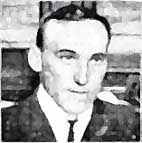

Here you can find some of the technological wonders and pipe dreams described in my scenarios, along with more information on the men and women behind them.
|
In 1938, Dr. Ludmila Haupstein, one of the first and youngest female graduates of the Berlin Polytechnic Academy, published several papers on her research into the infrared spectrum and the applications of infrared sensing devices to industrial and academic concerns. After her findings were received with general acclaim, she decided to indulge herself for a year or two in what she called her "hobby of choice," the linking of infrared sensors with tabletop computators to transmit brief bursts of data between the calculating devices.
A forward-thinking adjutant in the OKW sciences office heard about her experiments from a friend and decided to pay her a visit. After she demonstrated her devices, the adjutant, Lt. Oswald Rotlichtmann, had a sudden vision of a field application for her "hobby." Feverish with calculations, Rotlichtmann described his scheme to her and asked if she thought it was realistic. He proposed placing a computator-linked infrared projector on a vehicle, and covering most of the exterior of the vehicle with inexpensive receptor plates, linked to a separate computator. Two such vehicles could use her infrared devices to simulate firing at one another. Dr. Haupstein found the idea intriguing, and struck a pact with Lt. Rotlichtmann to present a proposal to the OKW research and development office and share whatever prestige resulted if they were successful. The first "Invisible Beam Weapon" testbeds were a pair of Panzer Is that rolled into simulated combat on October 6, 1939. The war in Poland was then drawing to a close, and the OKW was quite attentive to Haupstein and Rotlichtmann's amusing experiment. The testbeds were equipped with pairs of truncated computators linked to their infrared projectors and sensors. Each computator could send or recognize eight different infrared signals, each of which could be used to represent a distinct type of incoming fire. The sensor-linked computator would sound an alarm when it detected a successful attack, and a small light board would tell the vehicle commander what had hit them. The initial tests were a modest success, and General Heinz Guderian himself appraised the results as "promising." "At last," he wrote, "we may be able to train our men and machines at combat speeds, without the need to judge this and imagine that. We may move Kriegspiel out of the nineteenth century, and make it a true test for the men as well as the officers." Widescale use of the Unsichtbarrewaffen was first seen at a Kriegspiel in France in 1940. Modified computators and infrared equipment eventually increased the number of available signals to 16, and then to 32. The parameters of the beams could also be altered to simulate any manner of bizarre or prototypical weapon. Through the use of the Unsichtbarrewaffen, the Wehrmacht gained the ability to estimate the battlefield effects of its new wonder-weapons, at least to a certain extent. The Unsichtbarrewaffen had another side effect, slightly less well-known. Oswald Rotlichtmann and Ludmila Haupstein were married in a quiet but happy ceremony in Wittemburg, Austria on April 23, 1941. |

A rare photo of Dr. Ludmila Haupstein, circa 1938. Colleagues alternately described her as "a technical genius," "a killer horseshoes player," and "a real heartbreaker."
Related Scenarios: |
|
The von Lubeck family was a prosperous minor branch of Germany's illustrious Hapsburg lineage. The sons and daughters of the von Lubecks were noted over the years for their robust health and "perfect Teutonic vigor." It's not surprising, then, that the family had little time for Otto, fourth son of Graf Ulrich von Lubeck, who was permanently crippled by polio in 1901, at the age of twelve.
Otto spent most of his teenage years at one of his father's estates near Heidelberg, nurturing a growing hatred of his aristocratic relatives and an equally powerful attraction to mathematics. In 1908, he wheedled enough money out of his parents to travel to America, where he studied at the Massachusetts Institute of Technology for eight years. Though hampered by his crutches and heavy wheelchair, he was delighted to be getting on with his life far away from his family. He returned to Germany in 1916 via Switzerland, against his own desires and only because he feared being trapped in the United States should it eventually enter the war against Germany. The von Lubeck family's fortunes were crushed by the end of the Great War (Otto was delighted), but Otto himself was able to acquire a comfortable teaching position at a private academy in Zurich. He returned to Germany once again in 1928, moderately wealthy from the sale of several patents in Italy, Switzerland, and Sweden. He accepted a position as an associate professor of physics at Tempelhof University in Berlin, and it was during his residence there that his colleagues first began to comment on his obsession. "I will move," the wheelchair-bound von Lubeck told several of his peers over coffee in 1931, "I will move without motion. I will move without mechanical clumsiness. I will show you a way to pass through the eye of a cosmic needle." "Teleportation," his colleagues chuckled privately to themselves, "Teleportation, is it!" Dr. von Lubeck was placed on "extended academic leave" in 1937 after a mysterious accident destroyed the building in which he kept his semi-secret "test apparatus." Undaunted, unconcerned with the bloody rise of the Nazi party all across Germany, heedless of his own reputation as a bitter crank, he took up residence at a small rented cottage back in Heidelberg and pursued his dream of "instantaneous non-physical movement, via an inexpensive, easily-reproduced means." In 1938, Dr. von Lubeck approached OKW, begging to be allowed to "demonstrate his incredible success." Once he explained what this "incredible success" was, he was literally laughed out of his interview with a Colonel of research and development. The rebuff stung him bitterly, and he withdrew into a shell for more than two years. In 1940, he again approached OKW and offered a demonstration of his device. This time his offer was accepted by General Wilhelm Keitel himself. The general and his staff had anticipated a good laugh, but they were awestruck when Dr. von Lubeck's little device teleported a ping-pong ball across twenty feet of thin air. In an instant, the "Crackpot of Tempelhof" had the personal attention of the Fuhrer, and his device was placed on the fast track to replication on a massive scale. Subsequent events would prove this to be a terrible failure of judgment. |

Dr. Otto von Lubeck, circa 1942, shortly after the OKW review board inquiry into the "incident" of 19 October 1941.
Related Scenarios:
Related Resources:
|
|
June 16, 1941 was a lovely day in the rolling English countryside north of gray, bomb-damaged London. Colonel Reginald "Stuffy" Clapham of Combined Operations Command was en route to a staff meeting at an RAF command center when his driver spotted a cloud of dust rising several hundred yards down the narrow dirt lane. In just a few seconds, the dust cloud grew larger and much closer- the driver realized that a motorcyclist was barrelling directly for Clapham's car at an extremely impolite speed. Honking loudly proved of no avail, and the driver sat frozen in horror at his wheel as a grinning, leather-clad figure mounted on a Harley-Davidson WLDR grew ever-larger in his vision. "Oh, Christ," Clapham whispered, "it's Dewey."
A narrow instant before collision seemed inevitable, Lt. Cmdr. James Jeroboam Dewey popped a "wheelie" with his bike and jumped down on something resembling an oversized clutch pedal. Both he and his motorcycle vanished in a cacophanous explosion of flame and smoke, and Clapham's driver swerved the car to a teeth-clattering emergency halt. The driver and the Colonel stepped out into a cloud of dust and haze, expecting to find Dewey and his bike knocked into a thousand pieces before them. Instead, they both looked up just in time to see the daredevil Lieutenant Commander as he and his flaming Harley-Davidson fell from the sky two hundred feet behind them. The motorcycle exploded upon landing in a grove of willows and Dewey, slightly more fortunate, fell into a shallow mill pond, breaking only his left hip and both ankles. After interrogating Dewey and summoning an ambulance, Col. Clapham discovered that Dewey had deliberately set out to "ambush" him on the way to his meeting and thereby prove that his newest invention was capable of flight. Clapham, Dewey's nemesis in the hierarchy of Combined Operations Command, had been adamantly opposed to Dewey's "lunatic" fixation with rocket-augmented motorcycles. "Your contraptions are aerodynamically incapable of taking to the air!" he had shouted during one particularly heated procurement hearing. Dewey took the assertion very personally. "There you are then, sir," Dewey said with his characteristic cheerfulness, "landing needs a bit of work, but she's not quite so aerodynamically unsound as you thought." "Lieutenant Commander Dewey," said the Colonel, very softly, "do you believe that any future testing of these rocket bikes of yours will be just as dangerous as this little stunt-flight?" "Oh, almost certainly, sir." "And can you assure me that you'll continue to lead the development efforts yourself?" "I wouldn't have it any other way, sir." "Alright, then. As long as every passing week brings you a goodly chance of a swift and painful death, I shall give you all the funds and personnel your project requires. Are we agreed?" The rest, as they say, is history.
|

A painting of Lt. Cmdr. J.J. "Nads" Dewey done by a friend in 1939. Dewey consented only to a close-up portrait because his left leg and both of his arms were in casts at the time of his sitting.
Related Scenarios:
Related Resources:
|